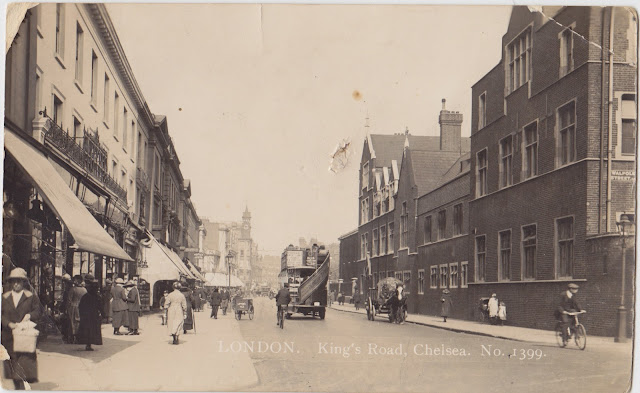Chelsea Then & Now
Continuing the series started on 21 July
Kings Road
Sloane Square
The Church on the right, Holy Trinity Sloane Square, was built between 1888 and 1890 by the 5 th. Earl Cadogan in an Arts and Craft style and features stained glass windows by Edward Burne-Jones and tile work by William Morris.
 |
| To Miss E Richardson in Hove; " De. E, I am in London for a few days, I have seen Percy he does not care for it, just my place, yours, Harry." The postage stamp is at an angle. |
Note how the street-scape has totally changed. The buildings on the right were destroyed during the war.
Chelsea Town Hall
The Chelsea Vestry, including the public baths, was built in 1858 to designs by W. Pocock, as shown in the postcard. In 1887 an addition was built to the rear of this building, facing Chelsea Manor Gardens. The Palladian style building was designed by JM Brydon. However in 1908 the Vestry part, facing the Kings Road above, was demolished to be replaced by the current building, designed by Leonard Stokes.
A Great Protest Meeting for Votes For Women was held at the new town hall in 1908. It was organised by the Chelsea Women's Social and Political Union. Tickets were available from a Miss Barry, The Library, 24 Park Walk. Women achieved partial suffrage in 1918 and full suffrage in 1928.
The message on the card reads; " Dear Mildred, Thank very much for your nice letter it was fine if any one sends a letter let me have it please, from your Mother". March 1908.
Peter Jones, Sloane Square
Peter Jones was founded by Peter Rees Jones in 1871 as a "Cooperative Drapery" on Draycott Avenue, moving to the Kings Road in 1877. In 1895 he built a new red brick five storey building on the site, as shown in the postcard above. Part of this older building can be seen at the rear of the present store in Seymour Place. In 1904 Peter Rees Jones sold the store to John Lewis for £20,000. John Lewis died the following year and his son John Seddon Lewis took over. In 1929 he introduced the profit sharing partnership scheme. His argument was that he should look after not only the customer "who exchanged money for his merchandise" but also the staff "who exchanged their work for his money". A philosophy that continues to this day.
The present iconic shop was built in 1935, the architect was William Crabtree together with CH Reilly. The modernistic style was much influenced by Serg Chermayeff.
Nikolaus Pevsner, the famous architectural historian, refers to the building as "still one of London's most likeable modern buildings".
The Royal Avenue
The Royal Avenue was laid out for King William III and Queen Mary in 1692-94 as part of a proposed Parisian style triumphal way leading from Christopher Wren's Royal Hospital up to Kensington Palace to the north. In true English fashion it only got as far as the Kings Road.
It was originally called Chestnut Walk, by 1748 it was referred to as White Stile Walk and was not called Royal Avenue until 1875. The closure to the Kings Road occurred in 1971.
The houses on the west side date from the 1830's, and on the east side from the 1840's and 1850's with post war replacements to the north end.
The Avenue was the setting for the cult movie " The Servant" written by Harold Pinter, directed by Joseph Losey in 1963 and starring Dirk Bogarde and James Fox.
On the corner was the famous 1960's phenomenon "The Chelsea Drugstore", based on "Le Drugstore" on Boulevard St. Germain in Paris. It was designed by Barnett, Cloughley and Blakemore in what was the White Hart Pub, dating back to the 1880's. It is currently a McDonalds!
Whitelands House
The original building was a girls boarding school, around 1772, which became a teacher training college in 1841. It was rebuilt in 1891 by Henry Clutton, again as a girls school. See postcard.
In 1881 the famous English art critic John Ruskin instituted an annual May Day Flower Festival at the school. A golden hawthorn cross, designed by the artist Arthur Severn, was presented to the chosen May Queen together with a copy of Ruskin's book "Sesame and Lilies".
The school moved to West Hill, Putney in 1930. In 1933 it became, briefly, the headquarters of Sir Oswald Mosley's British Union of Fascists, and became known locally as fascist Fort. The building was demolished in 1935 and replaced by the current block of flats.
Message on the card, dated August 1922 to a Miss D. Allen in Braintree ; " I expect you are thinking I have quite forgotten you. I am very well and have a good place. I have been here eight months now. If you care to write send it to my home as we are leaving here shortly, please remember me to all, with love to yourself from B.H".
The only original element is the first story detail on the left, the curved brickwork detail and the cast iron balcony, all the rest has changed.
The New Kings Road
The New Kings Road looking west with Broomhouse Road on the left, just beyond Parsons Green.



















No comments:
Post a Comment